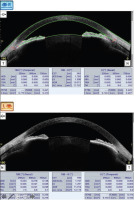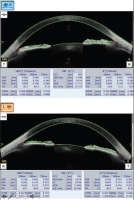INTRODUCTION
Drugs may lead to angle-closure glaucoma in multiple mechanisms: by pupil dilation, by blood-ocular barrier breakdown and by choroidal and ciliary body effusion [1]. The sulphonamide group of drugs leads to bilateral acute angle closure (AAC) as an idiosyncratic response [2-4]. Sulphonamide derivatives may cause transient myopia, ciliary body oedema, uveal effusion and anterior displacement of the lens-iris diaphragm, causing secondary angle closure [4]. In this article, we present a case of indapamide-induced bilateral acute angle closure and myopic shift.
CASE REPORT
A 34-year-old Caucasian woman presented to the ophthalmic emergency room reporting sudden bilateral vision loss 12 hours earlier. She denied trauma, any ophthalmic treatment and refractive error.
Indapamide and potassium therapy for mild systemic hypertension had been started 14 days before the onset of vision deterioration. Apart from that, she had irritable bowel syndrome (IBS) and anxiety disorder. IBS was treated with trimebutine for at least six months. Anxiety disorder therapy involved duloxetine, and it was ceased more than a month prior to the visit to the emergency room.
The autorefractometer (KR-8900, Topcon, Japan) examination showed refractive error of –4.75 Dsph/–0.5 Dcyl (ax 164°) in the right eye (RE) and –2.5 Dsph/–0.75 Dcyl (ax 75°) in the left eye (LE). Uncorrected visual acuity (UCVA) (Snellen chart) was 0.05 RE and 0.1 LE. BCVA was 0.6 (–1) RE and 0.6 LE. Near vision (Snellen chart) was full in both eyes (OU); however, she reported blurriness. The colour vision (Ishihara chart) and Amsler test were normal in OU. She denied orbit pain while checking ocular motility, which was normal and symmetrical.
On slit lamp examination the anterior chamber (AC) was shallow in both eyes, and iris bowing was noted. The gonioscopy showed 0 in the Shaffer grading system and “A 10 s” in the SGGS (Spaeth Gonioscopic Grading System). Enlarged ciliary processes behind the iris were seen in gonioscopy. The photopupillary reflexes were physiological. The lens was transparent. The macula and the retina showed no pathological findings. Intraocular pressure (Goldmann applanation tonometry – GAT) was 29 mmHg RE and 32 mmHg LE.
Anterior segment optical coherence tomography (AS-OCT; CASIA2, Tomey, USA) analysis was performed. The AC depth (ACD Endo.) was 1.75 mm OU. The iridocorneal angle showed iridotrabecular contact (ITC) in 81.9% in the RE and in 91.4% in the LE. The average trabecular iris angle (TIA 500) was 0.3° in the RE and 1.1° in the LE (Figure 1).
The patient was administered 0.5% timolol, 2% dorzolamide and 0.01% dexamethasone phosphate topically OU and 150 ml of 20% mannitol solution intravenously. Afterwards the IOP was 25 mmHg RE and 23 mmHg LE.
The blood tests were normal. RR was 120/95 mmHg. The patient was ordered to stop taking any general medication, and prescribed dorzolamide and timolol OU twice daily. The vision deterioration resolved spontaneously three days later.
Upon further follow-up AC was deep and IOP was 21 mmHg RE and 19 mmHg LE. The autorefractometer examination showed +0.25 Dsph/–0.5 Dcyl (ax 166°) RE and +2.0 Dsph/–0.5 Dcyl (ax 14°) LE. UCVA was 1.0 RE and 0.9 LE. BCVA LE was 1.0. Short-distance vision was full in both eyes. Gonioscopy examination showed “D 30 r 2+” in the SGGS, grade 4 in the Shaffer system, in both eyes.
AS-OCT showed ACD Endo. 2.77 mm RE and 2.67 mm LE. No ITC was noted, average TIA 500 was 34.4° RE and 31.4° LE (Figure 2).
Neither OCT of the optic disc and macula (Avanti, Optovue, USA), the threshold 30-2 visual field examination (HFA-II, Zeiss, USA) nor the ultrabiomicroscopy (UBM; Aviso, Quantel Medical, France) showed any pathologies.
DISCUSSION
Sudden myopia and iridocorneal angle closure may be a result of lens pathologies, posttraumatic conditions and ciliary body abnormalities. Bilateral change in refractive error and anterior segment anatomy leads to a suspicion of a systemic disorder.
The anatomic reason for a sudden myopic shift and secondary angle closure is anterior displacement of the lens-iris diaphragm by acute ciliochoroidal effusion. The mechanism involves eicosanoid level elevation and the inhibition of carbonic anhydrase [5]. Other factors are the relaxation of the zonules, anterior shift of the iris-lens diaphragm and ciliary muscle spasm [6].
Drug-induced transient myopia has been described as the side effect of numerous medications, such as sulphonamide and its derivatives, most commonly reported after topiramate, as well as benzodiazepines [4, 5, 7, 8]. Bilateral angle closure has also been recently reported as a side effect of daratumumab – a monoclonal antibody used in the treatment of multiple myeloma [9, 10].
The patient in this case report received trimebutine therapy for irritable bowel syndrome. Trimebutine is an opiate receptor agonist, and it has not been reported to cause the side effects that occurred in our patient. She also received therapy for anxiety disorder with duloxetine, which is a noradrenaline and serotonin reuptake inhibitor. However, duloxetine had been discontinued more than a month before the onset of vision deterioration.
In the literature there have been just a few previously noted cases of indapamide-induced myopia [2-4, 11-13]. The characteristics of the patients are listed in Table I.
Table I
Summary of the reported cases of indapamide-induced myopia
| Author, year | Patient’s age and sex (F/M) | Myopic shift [Dsph] | IOP [mmHg] | Days after drug introduction |
|---|---|---|---|---|
| Boissonnot et al. 1986 [12] | 41, M | 0.75 | “Normal” | 2 |
| Senthil et al. 2010 [4] | 53, F | 1 | 57 RE, 52 LE | 30 |
| Blain et al. 2010 [11] | 28, M | 5 | 17 OU | 7 (2 doses) |
| Vegh et al. 2013 [3] | 39, F | 7.25 | 25 RE, 24 LE | n/d |
| Pedrosa et al. 2019 [2] | 39, M | 3.25-3.75 | 36 RE, 34 LE | 7 |
| Takahashi et al. 2021 [13] | 60, F | 1.5-1.75 | 26 RE, 29 LE | 5 (3 doses) |
| Our case | 34, F | 5 | 29 RE, 32 LE | 14 |
Ultrabiomicroscopy has been a reliable method to evaluate the AC characteristics, ciliary body rotation and lens pathologies [3]. AS-OCT is an accurate tool for evaluation of the AC [7]. Performing AS-OCT examination does not involve applying pressure on the eyeball, and thus the examination is more physiological than UBM. AS-OCT however lacks the possibility of evaluating the ciliary body and its changes.
In most cases described above, the drug-induced myopia and the angle closure resolved spontaneously and did not lead to permanent injury to the optic system. There has been described no or little therapeutic effect of the cycloplegics used in order to break the ciliary block [11]. Some authors recommend the use of topical steroids and cycloplegic agents, which leads to deepening of the AC [3]. YAG iridotomy and pilocarpine, as well as lens removal surgery, do not cause a positive effect because they do not affect the mechanism of the disease, which is ciliary body effusion [3, 11]. Miotic agents and ocular hypotensive drugs on the other hand find use in drug-induced IOP elevation caused by a pupillary block secondary to adrenergic or anti-cholinergic drugs, which has to be taken into consideration as a differential diagnosis.
CONCLUSIONS
To conclude, our case report is one of the few in the literature to present bilateral myopia and iridocorneal angle closure induced by indapamide. Unlike other authors, we used AS-OCT as a basic tool to describe the characteristics of this condition. It needs to be highlighted that drug-induced angle closure should be suspected in any patient with symptoms of sudden-onset bilateral myopia and angle closure.

 POLSKI
POLSKI






